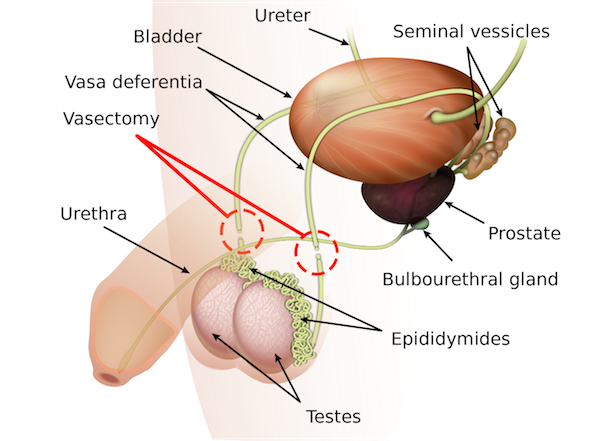Vasectomy
What Is Vasectomy?
Considered to be a permanent form of male sterilization, vasectomy is a common outpatient procedure performed to stop the supply of sperm to your semen. Vasectomy surgery has a high success rate and the probability of conceiving any children afterward is very low. Vasectomy offers many advantages as a method of birth control. The main benefit is effectiveness.
Vasectomy is named for the vas deferens (vas), the small tubes through which sperm travels on its way to the testicles and ejaculatory ducts. During vasectomy surgery, your Urology Center physician will remove a small piece of each vas and permanently close off the ends of the tubes. This stops sperm from mixing with semen and being released when you ejaculate. The body will instead absorb the sperm in a totally harmless manner.
Some men decide to store sperm in a sperm bank before having the procedure. However, if you’re already concerned about reversal, perhaps you should take more time to decide about having vasectomy.
No-Scalpel Vasectomy at the Urology Center
The board-certified urologists at the Urology Center are all experienced in the no scalpel vasectomy technique. This minimally invasive procedure is performed at our dedicated Ambulatory Center, located at our main office in Omaha, and typically takes about 30 minutes. No-scalpel vasectomy generally is performed under local anesthetic, but you and your physician may choose another form of sedation if desired. It is recommended that you have a driver for your trip home.
Vasectomies using the no-scalpel technique are performed through a tiny incision (approximately one-fourth inch), which decreases bleeding, surgical trauma and length of operating time when compared to the more invasive incision vasectomy. The risks associated with no-scalpel vasectomy are minimal. Common side effects are discomfort with scrotal bruising and swelling. Less typical is the occasional development of a blood pocket called a hematoma.
If you feel that you are having an unusual amount of pain, swelling or bruising after vasectomy surgery, please contact the Urology Center immediately.


What Happens After a Vasectomy Procedure?
Vasectomy is performed on an outpatient – or ambulatory – basis. Patients are released to go home afterward with these post-procedure recommendations:
- Rest for 24-48 hours after surgery
- Wear tight underwear or a garment that provides scrotal support
- Limit strenuous physical activity including sports, lifting and heavy work for at least one week so as not to cause pain or bleeding inside the scrotum
- Refrain from ejaculation for at least one week
- Avoid unprotected sexual intercourse until your semen has been checked and no sperm exists
It is important to note that you will not be sterile immediately after having a vasectomy. Before having unprotected intercourse, most patients require 24 or more ejaculations to eliminate the reservoir of sperm, followed by a semen test that confirms no sperm is present. You may need multiple tests before being cleared for sex without birth control.
Do Vasectomies Ever Fail?
Like other methods of birth control, vasectomy has a failure rate – however it is low. The risk of impregnation for men who have had a post-vasectomy semen specimen with no sperm is about 1 in 2,000. This means it is highly unlikely they will become fertile again.
Does Vasectomy Have Unwanted Side Effects?
Although vasectomy is a very routine and safe procedure, there are some potential complications:
- Hematoma: Bleeding in the scrotum can cause a blood pocket called a hematoma. After a few weeks, the body reabsorbs the blood and the scrotum returns to normal. In rare circumstances, a hematoma becomes oversized or bothersome and requires a follow-up procedure.
- Infection: Risk of infection is less than 1%. It is normal to have some redness and perhaps slight drainage from the incision site for a few days.
- Sperm granuloma: A hard, sometimes painful lump about the size of a pea may form as a result of sperm leaking from the cut vas deferens. The lump is not dangerous and almost always is absorbed by the body. Scrotal support and mild pain relievers (like acetaminophen) can help relieve symptoms.
- Chronic pain: About 1%-2% of men develop chronic pain in the scrotal sac after vasectomy, which can be treated with anti-inflammatory drugs, antibiotics, injections of cortisone-like drugs or anesthetic agents. In rare cases, chronic pain after vasectomy is severe enough to warrant additional surgery.
We urge you to call the Urology Center right away if you have signs of infection, such as blood oozing from the surgery site; a temperature of more than 100.4 F (38 C); or worsening pain or swelling.

